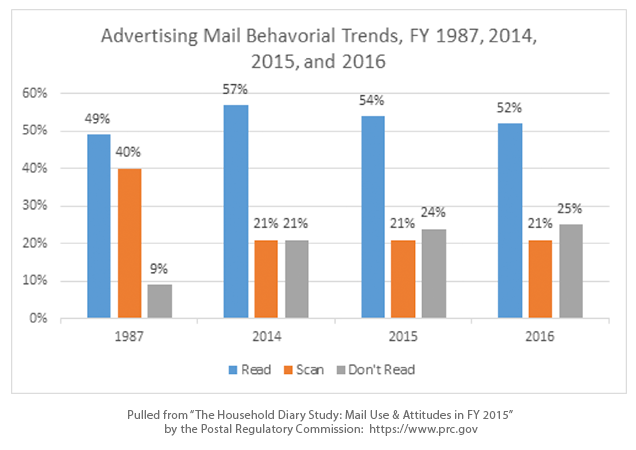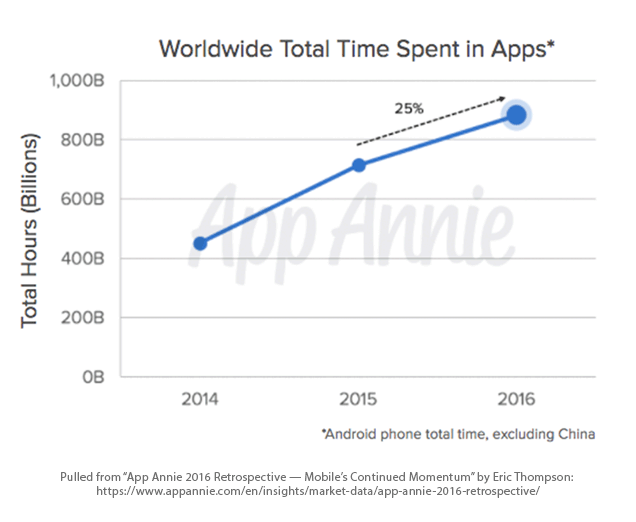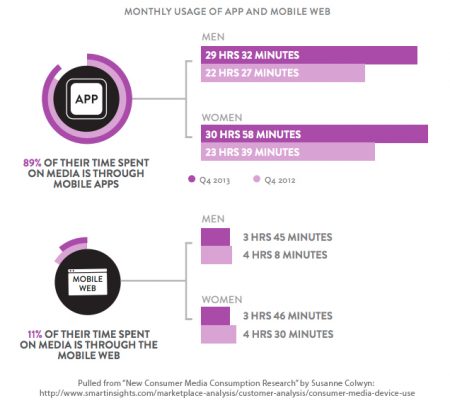Why Behavior Data Is The New Unfair Advantage You Need
 Two, 5 or maybe 10 years from now, the story of you and all the other companies in your industry will be exactly like Amazon vs. Walmart, Target, Sears, KMart, etc. There will be a couple who turned out sort of okay. There’ll be a lot of losers and one amazing success story. You can be the success story, and here’s how.
Two, 5 or maybe 10 years from now, the story of you and all the other companies in your industry will be exactly like Amazon vs. Walmart, Target, Sears, KMart, etc. There will be a couple who turned out sort of okay. There’ll be a lot of losers and one amazing success story. You can be the success story, and here’s how.
Everybody’s talking about mobile device data, big data and behavior data. But the real question is: How should you be using this data right now? (And yes, you should be.)
Think for a moment about how people act and what this tells you. For example, the armed forces know they’ve had a lot of success recruiting young people who:
- Have a veteran (or someone currently serving) in the household.
- Visited an armed forces website.
- Are taking some responsibility (looking for a job, getting a car or planning for college).
This is a great example of propensities. In this case, a person with a high propensity to join the military. People who behave a certain way are more likely to take an expected action. The more criteria they fit, the higher the propensity they have (the more likely they are) to act.
Notice the first item (veteran in the house) is a simple demographic. Marketers have known about and used demographics for years. And what about the website visitors? Cookies and targeting pixels can often be matched to specific people with their consent. (They entered their email, filled out a form or requested information.)
But what about the last item? Back in the day, there were only desktop and laptop computers. Now, almost everyone uses their mobile device.
Keyword tools can tell you what searches people type into Google. But can you see how the apps people install on their phones tell you so much about them? They tell you people’s lifestyles, habits, even the purchases they are about to make.
How can you use this information? Well, you could make a list of certain apps and target anyone who uses them. One little problem with that: tons of brand new apps are popping up on people’s phones every day. Your criteria is obsolete before you can use it.
How can you solve this? Categories. Every app falls into a finite number of categories. In the example above, some apps fall into the job-seeking category. Other apps are for college planning.
If you sell cars, imagine how useful it would be to know that someone in your area is searching for a car right now. Either on your lot or a competitor’s. Even if they’re searching for Fords and you sell Chevy – wouldn’t you like to know about them? And as you can see, behavior data not only tells you who – but can tell you when to make people offers.
It gets better. To get the best deals, consumers are happily revealing their location through their devices. And even the purchases they make. Can you see the opportunities here?
Yet there’s another reason you should be using behavior data now. Earl Nightingale, one of the first business philosophers said something really powerful:
“If you really want success…you can get a head start by looking at what everybody else is doing and do the opposite.”
It’s strange advice for those not familiar, but it’s a great strategy for those who are serious about improving their business. Let’s deal in reality here. Most people want 100% certainty before they dive into a marketing method. (And most people make excuses instead of progress, too.)
Mobile device data, behavior data and propensities are still new. And yes, there will always be a bit of unknown in any marketing strategy. Yet the risk behind behavior data is far lower, far safer than just using demographic data or all those marketing tactics people used in past decades. When you use methods like behavior data to narrow your focus and target a specific audience, you don’t just get a little better – your marketing gets exponentially better.
Not everyone will act on this. Some will just talk. Others will wait and see. And that’s why some companies will sort of do ok. Most of them will fail. And only a few will win big.
What will you do?
| Click here to learn more |
How to Succeed With The One Habit of Highly Effective Marketers
This one habit is everything: finding the right people.
Because let’s face it, this is more important than all the sales methods, copywriting techniques and negotiating tactics in the world. The wrong person doesn’t have the money. Or they don’t care. Or may not be as easy to convince.
If your marketing doesn’t get you in front of the right people, you’ll never sell. Plain and simple. Yet even this is not enough. In these competitive times, if you try to sell to everyone who will buy…you will fail.
Starbucks understands this. They know that 40 out of 100 people are willing to pay 50 cents for a cuppa joe. Yet they find and focus only on the 8 people willing to pay $2 to $5 for the luxury blends. (And this is why all those corner coffee shops went out of business.) If you’re not targeting the crucial 20% of your audience (or 10%), you need to learn how. And how do you do it?
Predictive analytic models.
Yes, there are a variety of these models to increase your revenues and delight your customers. But don’t let all the science or choices scare you. Here are some (hopefully) simple, real-world examples to help you know what to do.
Think of these models as tools in a toolbox. (You wouldn’t use a saw if you needed a hammer.)
First, just like in the Starbucks example above, you need to segment (or cluster) your audience. Who are the 50-cent people? Who are the $5 people?
This is not just demographics like age and zip code. Want to delve deeper and get a more profitable answer?
Customer Behavior
Some of your customers may be big spenders on their first order. Others may purchase less at a time but be more loyal, long-term buyers. Still others may buy more because of discounts. Do they contact you via your website, in person or use the phone?
Not only could you look at average order size or total revenue for each…what about days between orders? Total number of orders? Total items per order? Size of first order? Number of products in their first order? Percentage of spending on discounted items?
Let’s say you have a group of frequent buyers with small orders. A simple offer like this could really increase your profits: “Earn double reward points when you spend $20 or more.”
You could also segment your customers by product. Do they like coffee or tea? French or Italian roast? If you represent multiple brands, which brands do your best customers prefer? Which brands do they have the least interest in?
Have you thought through who your best customers are (or might be)? Talk to an experienced data provider about this kind of segment/cluster modeling to help you analyze your own buyer data. And once you know who your very best customers are, you still need to find more people like them. How?
Propensities Predict Profits
The best data companies can also match your best customers with their records – and find a whole lot more of the best kind of people, ready to buy from you. From this new, larger list, propensity modeling can rank each listed person a number of ways:
You can predict someone’s…
- Future lifetime value as your customer – even before they buy from you. This data also tells you their demographics, email and what channels they use to buy. Can you see just how valuable this is when choosing how to market to them?
- Share of wallet. For example, if a customer spends $100 with you, is this 10% or 90% of their total spending on this type of product/service for a given time period? If you know your future revenue potential with them, you can design campaigns to capture this money.
- Propensity to engage. If they don’t click on emails, you don’t want to send emails to them. Or you might see that they will answer the phone or open direct mail.
- Propensity to unsubscribe. This allows you to know how often to send them emails. If they are good buyers but likely to unsubscribe, send them emails, but less often.
- Propensity to convert. You already spend enough getting offers in front of people. Reduce your spending by only putting offers in front of people likely to respond.
- Propensity to buy. When you know who is ready to buy and who isn’t, you also know how aggressive to make your offers. And ready prospects don’t need high discounts. Stop eating up your margin with them. (But you might want to make more aggressive offers to get incremental profits from people who are still high value.)
- Propensity to churn. One auto insurance company used this model, calling it their Auto Insurance Switcher model. Think of how profitable it is to know who is likely to buy your insurance now but switch next year to get the current cheap rate. Instead, you can reduce ad spending while increasing profits – all by targeting people more likely to stay with your company.
What You Must Know About Propensities
Propensities, when used right, can be scary accurate. They can predict what people will do, long before even they realize what they are going to do. Yet this kind of math has lots of variables. Here are a couple common ways to fail:
- Use one provider to analyze your data, but buy your list from another vendor.
- Use one set of methods to select your best customers, but another set of criteria for your prospect list.
A good data partner can help you gather your data, compile reports, identify your audience and best prospects. Every winning company this coming year will take their data and their data partner very seriously.
After all, finding the right people is the one habit of highly effective marketers.
What will you do? How do you find the right people?
| Click here to learn more |
Direct Mail is Still an Essential Part of any Marketing Strategy
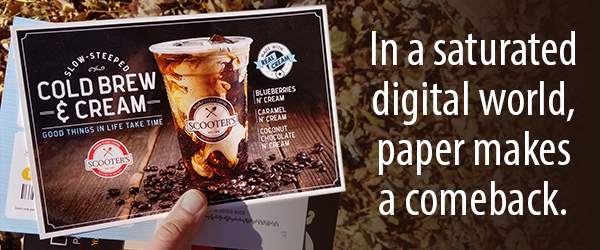 It would be easy to disregard the power of printed materials in a world on the verge of complete digitization. In terms of acting like consumers, there has been an obvious shift to the speed, efficiency and ultimate accessibility to our favorite products, brands and services via the Internet.
It would be easy to disregard the power of printed materials in a world on the verge of complete digitization. In terms of acting like consumers, there has been an obvious shift to the speed, efficiency and ultimate accessibility to our favorite products, brands and services via the Internet.
In fact, any modern marketing strategy is almost obligated to allocate a significant amount of resources to digital efforts: designing a sleek, user-friendly website, devising email campaigns and pushing social media to increase overall presence.
The immense proliferation of technology in the last few years would suggest that any need for a printed, direct mail strategy has been negated. However, in the pursuit of high-performance marketing, this is still a hugely valuable asset that when combined with powerful big-data insights, can bolster your overall strategy and ultimately boost sales.
Print’s dead, though, right?
Not only is direct mail still a viable marketing tactic, it could actually provide your company with an opportunity to stand out amidst all of the competition we now find online. While it shouldn’t be your company’s sole tool, it can act in a complementary role in terms of accessing your customers at the right time with a relevant message. While digitization has forced the newspaper and magazine industries to downsize and adapt, companies are still finding benefits from mailing their customers directly.
Why? For several reasons. First of all, it can be your company’s personal touch.
Mobile data is giving marketers better insights into what consumers are searching for, what they’re trying to purchase and when. This is critical in terms of designing targeted approaches to ensure consumers are actually benefiting from your marketing. However, it’s easy to lose any kind of personalization when everything is automated. With more complete and accurate mailing lists–informed by big-data–direct mail is still the standard for reaching out to customers with a personal touch.
 We still want very real things in our hands, which is something totally lost in email inboxes.
We still want very real things in our hands, which is something totally lost in email inboxes.
The flexibility of direct mail allows you to create something that can reach into consumer psyches more deeply than well-crafted emails. Something that is attention grabbing, boosted by rich visuals (as opposed to lengthy text on a screen), with a simple progression that directs the customer to follow your desired call to action, can propel consumers to either act or at least take notice.
Keys for an effective direct mailing strategy, in terms of the actual materials being sent (according to the Data & Marketing Association):
Be bold.
We have short attention spans. Marketing that cuts through the clutter with attention-getting graphics and copy more apt to gain and hold that attention.
Visuals rule.
In fact, the brain processes visuals exponentially faster than the time it takes the brain to decode text. Well used imagery can quickly get your piece noticed, and your message across.
Keep it simple.
Direct mail that creates a simple decision path with limited copy and explanation always tests better.
Furthermore, in an industry that finds immense value in data, direct mail can be directly measurable.
The United States Postal Service is an integral part of our country’s overall mailing industry. In fact, because it can deliver mail to every address (Every Door Direct Mail), companies like UPS and FedEx often piggyback off of its services. This is important because the USPS is able to constantly measure how much mail is coming and going, what kind of mail is being sent, and even whether or not people are reading their mail.
The United States Postal Service almost does the work for marketing researchers.
A large part of this is accomplished by the Household Diary Study (HDS), a survey that’s been conducted by the USPS since 1987. The metrics from this survey can provide insight to companies trying to make the most of their direct mail efforts. These metrics include total mail sent and received by households based on different demographics ranging from the age and size of households, education and income levels, and access to the Internet. According to this survey, in 2016 advertising mail represented 62 percent of all mail sent and received by households (about 79 billion pieces of mail). The culmination of this data, paired with the insights of mobile and big-data , make it possible for your company to appropriately and accurately determine how best to approach consumers.
Advertising Mail Received by Income and Education (Pieces per Household per Week)
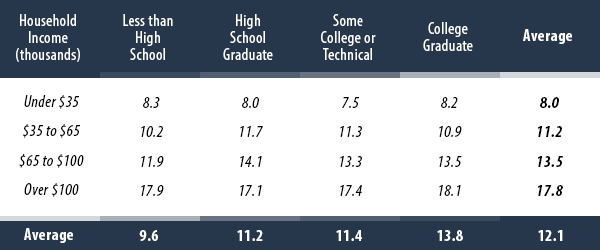
Advertising Mail Received by Income and Age (Pieces per Household per Week)
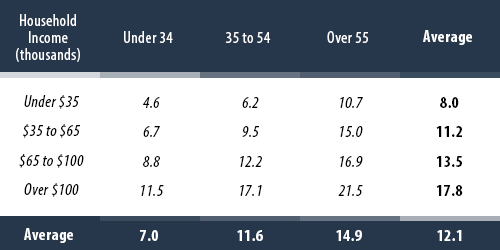
“73 percent of households either read or scan advertising mail received”
Ok, but what about the cost?
In terms of how cost-effective direct mail can be, it depends on how you decide to approach it. It can be expensive, especially if you’re sending out large catalogs chalk full of visuals and designs that require professional work such as copywriters, photographers, designers and printers. Opting for First Class mail (which means reaching your customers faster) can also bump the price up, but because of how flexible direct mail can be in general, it’s a cost-effective strategy that can be tailor made to fit any budget.
Contact us to learn more about how Direct Mail marketing can boost your prospecting.
| Click here to learn more |
The Shocking Truth About Your Marketing Channel
 Many people still believe you only need one marketing channel – and they couldn’t be more wrong. For example, malls are lined with countless businesses. And most of these shops rely solely on one thing: a crowded mall area to bring people inside to buy.
Many people still believe you only need one marketing channel – and they couldn’t be more wrong. For example, malls are lined with countless businesses. And most of these shops rely solely on one thing: a crowded mall area to bring people inside to buy.
Analyst Jan Kniffen says one-third of all the big malls in America will close their doors over the next few years. Nearly two-thirds of the remaining malls will struggle.
Industry veteran John Hazen asked his peers at a recent conference: “Is anyone not seeing large traffic declines?”
Why Single Channel Marketing Is Killing You
Consider this scenario: Brandon McDonald, of Nashville, Tennessee, walks into a local store. Brandon is excited about the Nikon digital camera he’s planning to buy and have in his hands today. Yet when he gets into the store, he decides to scan and check the price with an app on his phone. An online company is selling the same camera for less than what the store is now offering. Brandon decides to buy online and wait for his camera to arrive.
Why Selling Online Doesn’t Fix This Problem Either
Remember, Brandon first wanted to buy from the local store. Like so many customers, he loves to hold the camera in his hands–instant gratification. If only the store knew what Brandon wanted. It would have been win-win for Brandon and the store.
This problem doesn’t just plague retail stores and physical products.
The Secret To One Bank’s Success
One regional bank depended almost entirely on people walking into the bank and asking for a loan.
Yes, they have a website. But only about 1% of web visitors were submitting a loan request. The bank decided to look at data for their mobile and online visitors–surprise! They could recover the business of a significant number of people who abandoned the bank’s online loan form. Sales of current-account and personal loan products shot up 25%.
This is just one way that mobile insights are changing the face of marketing. And moving the whole world toward multi- and omnichannel marketing.
![]() Your Customers Expect Multi & Omnichannel Marketing
Your Customers Expect Multi & Omnichannel Marketing
As you can see, marketing to people through multiple channels or methods increases your ability to sell and profit. Omnichannel marketing means tying these methods or channels (apps, digital tools or shopping venues) together in an easy-to-use, consistent way for even more profit. More and more, customers are expecting this kind of buying experience. They want to hop on their phone or device and see exactly what inventory you have available. Or they want to shop online and pick products up at your local store.
The Numbers Don’t Lie
Rice University studied 46,000 shoppers for a 14-month period.
Only 7% shopped online exclusively. And 20% visited stores without using any other apps or venues. A whopping 73% used multiple channels in their shopping journey. These multi/omnichannel shoppers absolutely love touchpoints – in all sorts of combinations and locations. Touchpoints like offers to compare prices and download coupons.
In fact, they are avid users of all sorts of mobile tools such as interactive catalogs and price checkers. They bought online and picked up at the store. They bought at the store and got their products shipped.
Multi-channel and Omnichannel Shoppers Are More Valuable
And those who used multiple channels spent 4% more in the store and 10% more online than the single-channel folks. In fact, those who used 4 or more channels spent 9% more in-store than the one-channel shoppers. And those who used apps to research online first? They spent 13% more in-store. Six months after these shoppers had their first omnichannel experience, they were shopping 23% more. And they were far more likely to recommend their chosen brand to friends and family.
The “Killer App”
No wonder many are calling omnichannel marketing the “killer app” – because it’s saving the future of so many businesses. Despite the bleak future of single-channel businesses, you now know the secret that empowers you to reach your customers at the right time, with the right message. It’s why the most successful marketing campaigns today are omnichannel campaigns. It’s how you give your customers what they really want.
How will you use omnichannel marketing?
Contact us to learn more about how multi-channel & omnichannel marketing can improve your prospect marketing.
| Click here to learn more |
The Power of Mobile Data in a Data-Centric World

Modern marketing is fully embracing the explosive emergence of mobile-based consumer data. Because of its ability to capture a more accurate snapshot of when consumers are seeking out a particular company–or its products and services–mobile data has created a step-change in how marketers are crafting and delivering their message. Consumers are seeing this change manifest itself into today’s highest performing omnichannel strategies; which is connecting them with the right message, through the right channel, and most critically… at the right time.
It’s estimated that by 2020 more than 80 percent of adults worldwide will have mobile devices. This is going to continue to drive up social media usage, increased families with multiple devices, and even more data for marketers to utilize to better connect with consumers. Smartphones and tablets have given consumers real strength in terms of providing them with multiple platforms to access businesses, for finding information on products and services, and to even purchase those items.
What Do the Numbers Say?
How much data the world currently uses is creeping up, rising from 7 exabytes per month in 2016 to 11 exabytes per month in 2017, with a predicted increase to 17 exabytes per month in 2018 (one exabyte is one quintillion bytes). However, that number could increase exponentially to 49 exabytes per month in 2021.
According to a survey developed by App Annie, worldwide app downloads in 2016 exceeded 90 billion (an increase of more than 13 billion). During this time, the number of hours that consumers spent using these apps boomed by more than 150 billion hours to almost 900 billion hours. While this will add an incredible amount of data for marketers to sift through, it will also lead to more accurate, relevant marketing lists that will allow businesses to reach out and connect with consumers at the right time, in the right way.
“Increasing the quality of sales leads, improving the quality of sales lead data, improving prospecting list accuracy, territory planning, win rates and decision maker engagement strategies are all areas where big data is making a contribution to sales today.” said Forbes’ Contributor Louis Columbus.
What Does This Mean For Marketers?
What this information will allow marketers to do is to gain better insight into when, where, and how consumers are spending money. It also empowers businesses with the means to evaluate the performance of their product and services in the market; such as determining pricing and placement.
The number of devices consumers have access to is increasing; the number of apps being downloaded and the time spent on them is increasing; and marketing dollars used in the mobile space are increasing; all because of how quickly consumers are incorporating new technology into their lives. Generation Z is being raised with devices in their hands while millennials perpetually push technology and app trends (such as boosting Instagram, Facebook, Twitter to new heights). It has become obvious that with such an integration of technology into our daily lives, marketers are going to be inundated with information about its consumers from across multiple channels in order to connect with them with relevant and timely offers.
The Emergence of Life Event Marketing
It has become apparent that the insights from mobile data can provide businesses with opportunities for identifying when consumers are experiencing a significant life event. If a particular consumer has entered into a fairly monumental life phase (which usually involves large, complex purchases) chances are they’re using several apps or platforms to access the products and services associated with these events. This is valuable information for marketers, which is reflected in a study conducted by Royal Mail Data Services. In 2014, only 15 percent of marketers surveyed saw life events as a new sales opportunity, 32 percent surveyed said those events provided a reason to engage with customers. In just a year, those numbers jumped to 50 percent and 70 percent, respectively, indicating how marketers were viewing these particular moments to connect with consumers.
Contact us to learn more about how mobile insights can improve your marketing.
| Click here to learn more |
Can Mobile Data Win Sales & Make You More Money?
 Ten times the response rates of traditional marketing campaigns. That’s how Pamela Oldham of DMNews describes it. If your company is smaller than Walmart or Microsoft, you might not have heard about using mobile data and marketing this way.
Ten times the response rates of traditional marketing campaigns. That’s how Pamela Oldham of DMNews describes it. If your company is smaller than Walmart or Microsoft, you might not have heard about using mobile data and marketing this way.
Why?
Until recently, it’s been very hard to do …unless you had a team of data scientists and PhD’s on your payroll.
You’ll Want To Understand This, So Let’s Compare A Few Things
Back in the days of newspapers, magazines and TV, marketing was still simple. There were only a few ways to get your message in front of people. Yet this kind of marketing was severely limited. Marketers could only guess who was watching TV. People learned how to fast forward over the commercials. Along came the internet, the desktop PC and web browsers.
Google figured out how to make the whole world come to them and type out exactly what they were looking for. Because of this, Google reigned supreme for a few years. But little did Google know the size of the pandora’s box they opened.
People were getting used to immediately accessing the offers they wanted to see. Marketers were starting to get an inkling of how to reach the right people at the right time with the right message.
Retargeting pixels, for example.
These little bits of web code were like a trail of breadcrumbs that could tell advertisers even more about what people wanted. Yet the more data was available, the more complicated marketing became.
The Mobile Explosion
Suddenly handheld phones and devices could do what those big clunky desktop computers could do. Mobile put a tiny super computer within reach of just about everybody. In 2015, there were about 4 to 5 billion iOS and Android devices in the hands of consumers (compared with about 1.6 billion PCs). So said Forbes and Benedict Evans, a mobile technology expert and partner at Andreessen Horowitz. Forbes
By 2020, Evans estimates that 80% of adults worldwide will have a smartphone. Winston Crawford, COO of Drawbridge, says that the average US family has about three devices per person, including items like smart TVs, gaming devices, tablets, laptops, and phones. That’s potentially more than a dozen devices per family.
Making matters even more complex, online consumers might research a product on one device, but then make the purchase with another device. People don’t even use web browsers or even good old Google like they once did. According to Nielsen studies, people significantly prefer to use apps like Facebook, Instagram and Uber. Smart Insights
The data from these apps are not yet discoverable by Google or other search engines. Yet smartphones generate a giant stream of behavioral data. Everything from location to browsing and buying habits.
What does the data say?
For a while, nobody knew. There was just too much of it! Big corporations started buying big buildings and filling them full of computers. All of them straining to warehouse and analyze all this data. Of course, this meant hiring teams of data scientists. Highly paid experts who knew the tricks for finding the useful info hidden in the noise.
Most businesses don’t have the resources to store or analyze this data in-house. Nor can they hire the data science skills. Yet there’s a way around all this.
Why Mobile Data Can Help You Now
When big business started storing all this big data, they needed to make things simpler. So, they created the cloud.
What is the cloud?
It’s simply a group of connected computers designed to run apps or provide a service.
What does this mean for you?
Now you can access the same services, the same data analysis…that was once only available to the biggest companies.
Demographics Vs Mobile Data
In the old days, marketers used demographics. Let’s say they targeted ads towards 23 year-old females in Los Angeles. Yet people are completely different, even within this demographic. They like different brands, some are single, some are married. All of them are at different points in their life. Only a few of them might be interested in what you offer. With mobile data, you get an immediate list of highly interested prospects. They are all different ages, different demographics…but all of them want to talk to you.
Why?
The Power of Mobile Data And Right Time Marketing
Consumers are leaving more and more clues for marketers to analyze. Let’s say they have some important life event coming up. They’re getting married, buying a house or having a baby. The apps they use and their activity shows they’re engaged in searching for a loan. Or insurance, a car or a home.
How valuable is this information to you?
Since you provide these products or services, you reach out to them with a personalized message, using their name. They’re searching. They want offers in front of them. They want to find you. And because of the way apps and mobile work, they’re expecting you to talk to them.
No wonder this marketing has 10 times the response rate!
Brands, large or small, who reach out during these crucial life moments can retain previous customers and create many new, loyal customers for life.
Contact us to learn more about how mobile insights can improve your marketing.
| Click here to learn more |

